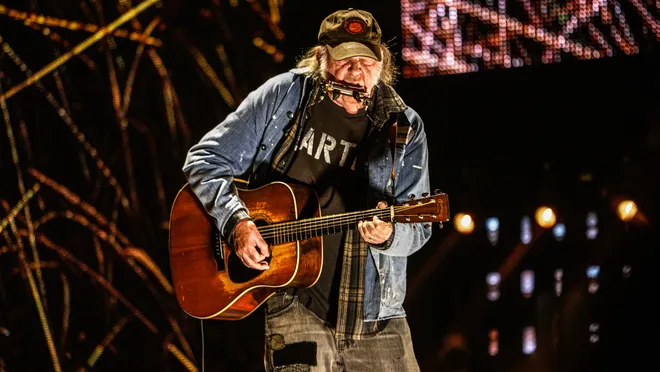Neil Young performing on stage in 2024. Neil Young stands at the edge of the stage, eyes closed as the final chord from his battered guitar rings out into the cool night air. In that moment of reverie, the 79-year-old rock legend seems both timeless and immediate—an old troubadour with a fire that hasn’t dimmed. For over half a century, Neil’s music has been a constant companion to those seeking authenticity and heart. And here in 2025, he still finds new ways to make every note feel urgent, every lyric personal, carrying the weight of years in a voice that trembles with passion.
A Harvest of Songs
In the hush after that last chord, one can almost hear echoes of the anthems that made Neil Young a household name. Classics like “Heart of Gold” and “Old Man” earned him a place in rock’s pantheon decades ago, but Neil is not one to rest on nostalgia. In the past few years alone, he has poured himself into new music with the vigor of a man half his age. His 42nd studio album, World Record (2022), is a mellow yet off-kilter meditation on the environment—mourning what’s already been lost while still expressing a glimmer of hope . To listen to these recent tracks is to recognize the same soul behind After the Gold Rush and Harvest. The gentle acoustic strums and earthy harmonica of those early classics are alive in Neil’s newer songs as well, threading the decades together.
He has always had an ear turned toward the Earth. As a young man, he imagined a ravaged future in “After the Gold Rush,” and as a seasoned artist in 2015 he railed against corporate agribusiness with The Monsanto Years . Those concerns have only grown more urgent with time. With World Record, he found an overarching theme emerging in song after song: a love letter to a planet in peril. It’s as if the earth itself whispered melodies to him on walks through his Rocky Mountain home, each tune carrying a plea to protect the land and water. Long an outspoken environmentalist, Neil sees no reason to temper his message now. If anything, the passion in his recent music feels like a plea from an elder statesman of rock who knows there’s more at stake than ever.
For Neil, creating is as natural—and necessary—as breathing. He’s been in constant motion ever since the days of Buffalo Springfield in the late ’60s, forever writing, recording, and exploring new sounds, making more music than could ever be released in a single lifetime . Even a global pandemic couldn’t slow his muse; when touring paused, he strummed fireside sessions at home and combed through his archives, unearthing gems for his fans. It’s this relentless drive that keeps his art evolving. One moment he’s the electrified shaman from Rust Never Sleeps unleashing a distorted guitar solo, the next he’s a lone figure on a stool, picking out the first fragile notes of “Harvest Moon” to a hushed crowd. Through it all, that unmistakable voice of his – cracked and plaintive, warm and unvarnished – binds the eras together. The same man who once searched for a heart of gold is still on that journey, inviting us along for the ride.
Speaking Truth to Power
Neil Young has never separated his music from the world it lives in. Give him a stage and he’ll sing, but he might also pause between songs to speak from the heart. Lately, those moments off the setlist have turned toward the state of the country he calls home. The man who in 1970 immortalized the Kent State tragedy with the furious protest song “Ohio” is still raising his voice at injustice, only now his gaze is fixed on the modern corridors of power. In interviews and open letters, Neil has been candid and impassioned about the political climate. “Increasingly democracy has been hijacked by corporate interests,” he warned, lamenting how the big money needed to run for office and the lobbying of special interests mean that “well-funded legislative decisions all favor corporate interests over the people”. He doesn’t hide his frustration with a system where deep-pocketed donors can all but choose who gets to run, drowning out the voices of everyday folks.
For Neil, it’s a simple equation: a government bought by corporations cannot truly serve its people. He has no use for politicians who chase money over principles. “I do not trust self-serving misinformation coming from corporations and their media trolls. I do not trust politicians who are taking millions from those corporations either,” he wrote bluntly, making clear where his faith lies. “I trust people. So I make my music for people, not for candidates” . That creed has been a constant through his life—whether he was defying a U.S. president by refusing to let “Rockin’ in the Free World” be co-opted as a campaign song, or standing up for farmers and the environment against industry giants, Neil’s compass invariably points toward the people on the ground. His critiques of the powers-that-be carry the weight of someone who believes deeply in the promise of America, even as he calls out its shortcomings. In his raspy voice, there’s disappointment, yes, but also a fierce protectiveness—like a loving but frank friend telling hard truths. He reminds us that freedom isn’t just a word in a song; it’s a right that must be guarded against those who would sell it to the highest bidder. And he’ll be damned if he doesn’t use his freedom of speech to do exactly that.
Long May You Run
That fighting spirit fuels Neil as he looks down the road ahead—quite literally. After years of limited live shows, he is preparing to embark on a new journey in 2025: a full-fledged tour that will carry his music and message to audiences far and wide . Under the banner of the “Love Earth” tour, Neil will share the stage with a new band of kindred spirits—fittingly dubbed the Chrome Hearts, featuring Micah Nelson (Willie Nelson’s youngest son) on guitar —and roll through summer nights from North America to Europe. It will be his first return to European soil in six years, including a stop at one of the UK’s most storied festivals, where tens of thousands of fans – many young enough to be his grandchildren – will raise their voices with his in unison. Night after night, from small theaters to vast fields, those fans will get to experience the electricity of Neil Young in person: the feedback moan of his old Les Paul guitar, the sweet sorrow of his harmonica, and that weathered voice delivering songs about love, loss, and living free.
To see Neil Young live in 2025 is more than a concert – it’s a communion. The air will crackle with history and possibility as he balances old classics with new galvanizing anthems. When he sings “Keep on rockin’ in the free world”, it’s not just a closing number – it’s a call to stay awake and engaged. When he strums the tender chords of “Old Man,” there’s an added poignancy now; the once-young songwriter is an old man himself, and the audience can feel the lifetime of wisdom and weariness in every line. In these moments, the boundary between music and message dissolves. The crowd isn’t just witnessing a performance; they’re sharing in a story that started long before many of them were born and is still unfolding in real time.
Neil’s journey continues, and we are all fortunate to be witnesses. As the final encore fades and he waves that familiar cowboy hat in farewell, there’s a sense that his fight and his song are far from over. Long may you run, Neil Young – long may you run.
LeBib Tip
Tickets go on sale on 11.4.2025 at 12:00 CET
Neil Young, J Balvin, Brandi Carlile, Benson Boone, Noah Kahan & Shaboozey at
2025 Montreux Jazz Festival

